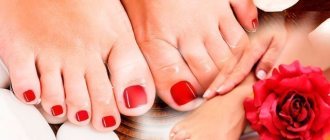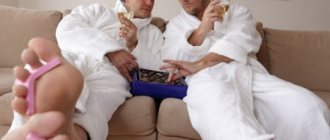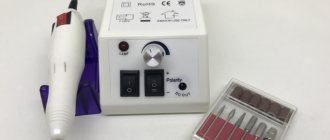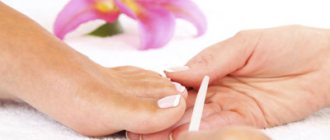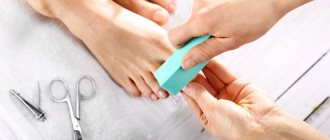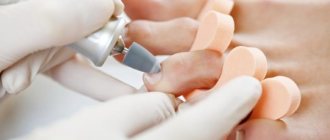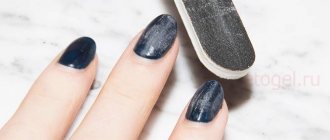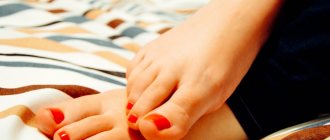What is the essence of the procedure?
Using a hardware version of pedicure, nails and feet are treated with a special machine, which polishes off unevenness, corns, rough skin, and eliminates other problems.
It is considered a more advanced method in contrast to classic pedicure, in which the foot is treated with a blade, grater, water and special softening creams.
Hardware pedicure and its results
The pedicure machine uses attachments with an abrasive surface that rotate at speeds of up to 50 thousand revolutions per minute. Experienced professionals not only eliminate minor defects, but also solve problems of cracks, ingrown nails, and fungal infections.
The standard version of the hardware pedicure technique includes treatment of heels, toes, keratinized areas, cuticles and overgrown nails. There is also an untrimmed method without mechanical removal of the cuticle; in this case, it is only gently moved with a stick. The most enjoyable spa pedicure is when steaming, peeling and massage are performed before using the machine.
It is believed that it is quite difficult to carry out such processing correctly at home. However, pedicure machines have been in great demand lately. This technology is especially easy for those who are masters of classic manicure and pedicure. But mastering it from scratch is also possible, the main thing is to have the desire and a good professional apparatus.
Beautiful legs after a hardware pedicure
Famous brands of pedicure devices
It’s not difficult to guess that the most expensive machines will be intended for professional pedicures, and the cheap ones – for home use. Here is the main list of manufacturers:
- Planet Nails
- Bradex
- Jessnail
- Luazon
- Marathon
- RuNai
- Soling
- Strong
- Vigor
For home use, a machine costing from 500 rubles to 3000 rubles is suitable. It is better for a professional pedicure and manicure specialist to turn to more expensive devices costing from 10,000 rubles.
Look at the review of the most popular professional devices for manicure and pedicure:
What is needed for a hardware pedicure?
To get a quality pedicure, you first need to decide on the device. There are now many models on the market, differing in the number of special attachments (mills), power and design.
Universal machines suitable for hardware manicure and pedicure are in high demand. It is important that the device has a power of at least 40 watts, a rotation speed of at least 15 thousand revolutions per minute, as well as the possibility of reverse reverse.
One of the main conditions for multiple comfortable pedicure procedures is the availability of a set of cutters, which will contain all the necessary caps:
- small diameter attachments for removing overgrown nail edges;
- large attachments for removing rough skin, calluses and corns;
- spherical and needle-shaped burs for processing the side roller and removing the cuticle.
Also from the inventory you will need a bath for washing your feet, buffs for polishing, moisturizing and nourishing creams, colorless and decorative varnishes.
Example of a machine and attachments for hardware pedicure
In addition to size and shape, cutters differ in composition and rigidity.
Standard types of nozzles for the hardware method:
- Diamond caps are cutters with color-coded cuts, where black is a rough tip for shortening nails and removing calluses, blue is a medium-hard tip for light seals, and red, yellow and green are soft for neat treatment of feet and cuticles.
- Ceramic tips are ideal for beginners, as they are softer and safer. The softest ones are blue and pink, the medium ones are white, brown and black are the hardest.
- Silicon carbide - disposable sand caps, fixed over the cutter, also provide for three-stage processing.
In order to accurately determine the need for a particular attachment, you need to carefully evaluate the rigidity and area of problem areas. Based on this, the stiffness and size are selected.
Types of cutters for hardware pedicure
If you do a pedicure not only for yourself, but also for other people, you need to take care of sterilizing the device and cutters, wear gloves, a mask and an apron, and also choose a comfortable chair and lamp.
What do you need to know about hardware pedicure to do it yourself?
First of all, pay attention to the device itself. There are several main types of pedicure devices - professional and those recommended for home use. The most important difference between such devices is that a professional one has more power and is ready to work 8-10 hours a day continuously, but a household tool, on the contrary, has less power and cannot cope with such a load.
If you don’t have a beauty salon at home, you can safely take the most ordinary household appliance and you won’t regret it.
Step-by-step instructions with photos
A careful study of processing technology helps you quickly master the use of a pedicure machine.
Here are some important tips from the experts:
- Move the machine in the opposite direction from its rotation, do not stop in one place;
- Do not press the cutter too hard against the skin to avoid damaging it;
- For the first time, operate at low speeds, below the recommended speed;
- Position the cutter at an angle of 30-40 degrees to the surface;
- Process the cuticle from the center to the edges;
- Walk along the nail folds along the growth of the nail.
The stages of the procedure will depend on the number of attachments in the kit. Stepped, gradual processing will be preferable for a smoother, cleaner effect.
Classic step-by-step instructions:
- Prepare your feet by wiping off the old polish with a solution. If there is gel polish, remove it using a grinding cutter, after treating the nail plates with acetone and foil.
- Wash your feet in cool or warm water and soap and dry well.
- Apply an antiseptic solution to the entire surface of your feet and toes and wipe with a clean towel.
- Treat the skin of the feet with a large, hard cutter, remove non-inflamed calluses, corns and rough skin of the soles.
- Next, use a medium-abrasive nozzle, eliminating small irregularities, paying special attention to the treatment of the heels.
- If there are cracks on the heels, outline the formation with a thin nozzle.
- Using large, soft cutters, sand and polish the entire skin of the feet until smooth.
- Use a small soft brush to work on the side ridges and between the toes.
- Remove cuticles using a needle cutter or a diamond cutter with a ball end. If you are afraid of damaging the skin, then treat the cuticle with an emollient for the first time and move it away.
- File off the required part of the edges of the nails with a medium-abrasive cutter and give the desired shape.
- To polish the nails and pterygium, use a felt or rubber tip or use a buff.
- Wipe your feet with a disinfectant.
- Apply moisturizer and apply a light foot massage.
- Finally, you can apply varnish - healing, strengthening or colored. Do not forget to degrease the nail plates from the cream before doing this.
Step-by-step instructions for hardware pedicure: first stage
Second phase
Self-training in hardware pedicure may take time, but gradually the skill of selecting cutters will improve, and the movements will become correct and as accurate as possible. After just a few procedures, it will be possible to appreciate all the advantages of this technique.
Step-by-step actions when treating toes with the device
This difficult procedure takes a lot of time and includes several stages:
- Treating the skin and nails with an antiseptic agent to eliminate the possibility of infection.
- Correction of the length of the nail plates with scissors or tweezers, or in difficult cases with nippers.
- Rubbing a softening keratolytic into the skin of the feet.
- If necessary, additional cleansing of the skin of the feet is done in cool water.
- The master uses protective equipment - puts on special glasses and a mask.
- Remains of the softening gel are removed from the feet using a paper towel.
- Processing begins with the feet. The nozzle used is 60/60 abrasive, coarse-grained, with a rotation speed of approximately 10,000–12,000 rpm.
- At the next stage, the cap is changed to a fine-grained one (100/100 abrasiveness), and polishing is performed. When the skin turns pink and acquires a slight yellowish tint, it is time to end the treatment.
- The feet are cleaned in water or an aqueous solution.
- Next comes the processing of the toes. A keratolytic agent is applied to the skin located between the fingers, then wiped off. The softened skin is processed in a cone shape with a blue or light blue ceramic nozzle.
- Then the nozzle is changed again - a cutter with a smaller grain size is installed, usually it is painted pink or red. The skin on the fingers is polished.
- The cuticles and side rollers are lubricated with special oil, after which the latter are processed at minimum speed (up to 6,000 per minute).
- A diamond-coated ball attachment is installed for careful processing of the cuticle.
- Finally, the nail plates are polished using a felt nozzle until a characteristic shine appears.
- Finally, the feet are carefully treated with a natural moisturizing cream.
Use the time immediately after the procedure to rest - the skin of your feet needs to absorb the remaining cream. If desired, it is possible to apply various decorative coatings to the nail plates. It is necessary to follow the specialist’s recommendations for caring for your feet at home. Skin masks, nourishing and moisturizing creams, evening baths will not only prolong the effect of the procedure, but also help relieve fatigue at the end of a long day.
In the interval between visits to the pedicurist, you can independently adjust the shape with a file, directing it from the edge to the center of the nail. It is strictly not recommended to touch the corners of the nail, since such actions often become the beginning of its ingrowth.
Advantages
The hardware method is increasingly replacing the classic trimmed pedicure due to the absence of disadvantages. The only downside may be the need to spend money on purchasing a good device and cutters. However, the impeccable results are worth the investment.
Photos before and after hardware pedicure
Advantages of hardware pedicure:
- safety from cuts and other damage, thereby eliminating infection by fungus or bacteria;
- all items are easily disinfected; for greater confidence, there are disposable nozzles;
- delicate treatment suitable for sensitive skin, even children's;
- the result lasts longer, the procedure can be performed once a month, unlike the classical method, recommended for every two weeks;
- copes with most problems - hyperkeratosis (roughened layers of skin), ingrown nails, corns, heel cracks and spurs, hardened calluses, fungal diseases, thickening of the nail plate;
- does not require preliminary steaming, all manipulations are performed dry;
- much less time is spent than with manual instrumental techniques;
- the procedure is painless and does not cause discomfort;
- has no contraindications, suitable even for patients with diabetes and varicose veins.
Beautiful legs after a pedicure
The well-known truth that proper foot care has a beneficial effect on overall health makes many people think about acquiring the skill of doing a hardware pedicure on their own. With this device you can be confident when wearing open shoes, as well as visiting the beach or pool. After all, the hardware method is great for maintaining the beauty and softness of feet for a long time.
Preparing feet for hardware pedicure
The most important difference between a hardware pedicure and any other is the approach to softening rough skin. For a hardware pedicure, the feet are not steamed in water, but a special gel is applied that recognizes only dead skin particles and does not affect healthy epithelium. You can easily purchase such a gel in any specialized store; it is not at all expensive, but it is thanks to it that the skin of the feet remains soft longer.
If you don’t have this special gel on hand, and you need to do a pedicure very urgently, then don’t worry, you can steam your feet in a warm soapy solution (but in this case, you need to start a pedicure not immediately after you remove your feet from the water, but after waiting 5-10 minutes and wiping your feet dry).
You should always remember that pedicures are usually done every 21 days, in order to avoid the appearance of cracks and other troubles associated with improper foot care. A home hardware pedicure is less aggressive than a blade, pumice stone, brush or any other type of pedicure, so you can safely do this procedure at home every week, refreshing not only the skin on your feet, but also the color of your nail polish. This will be very important especially in the summer.
Types of manicure and pedicure in beauty salons
When visiting a salon, you need to know what types of procedures there are. For example, manicure and pedicure can be:
- classic;
- hardware;
- European;
- SPA;
- female;
- male.
Classic manicure and pedicure are considered the most common procedures. For example, the first one is performed in the following sequence:
- removing old varnish;
- filing and shaping nails using special hard files;
- soaking your hands in warm water, for example with the addition of sea salt, for 5 minutes;
- wiping fingers and trimming cuticles and other excess skin using special tweezers and scissors;
- hand massage with cream and oil;
- nail polishing (in some salons it is included in the standard procedure, while in others it is paid separately);
- coating of nails with varnish.
A pedicure in its classic form is performed in the same way. Please note that before getting a pedicure in the salon, check the list of services that are included in the standard procedure and which are performed for an additional fee.
SPA pedicure
Recently, the so-called “spa pedicure” has been appearing more and more often on the cosmetic services market. The classical or European technique is complemented by a pleasant ritual of care and relaxation, including peeling, nourishing foot masks, creams and oils, and massage. The feet are treated with an antiseptic gel and immersed in a hydromassage bath with Dead Sea salts. The spa series involves the use of European cosmetics based on thermal water and mud, which effectively cope with dry calluses and corns. Experts assure that the special composition of spa products even prevents their reappearance.
Hardware and European manicure and pedicure
Hardware manicure and pedicure are directly related to European manicure and are one of its varieties. Before performing it, a special cream is applied to the cuticle or cut off using a machine equipped with a small diamond attachment in the shape of a ball or oval. In this case, hands and feet do not require pre-soaking. The main role in such procedures is played by special attachments.
European manicure and pedicure are performed with mandatory softening of the cuticle (using oil or special cream). Then the completely softened skin around the nails is removed using a wooden or orange stick. Afterwards, the nails are polished and take the desired shape. At the end of the process, your hands or feet are massaged and your nails are varnished. Here's how to do a pedicure in a salon according to the European style or using a special machine to trim and file away all excess.
